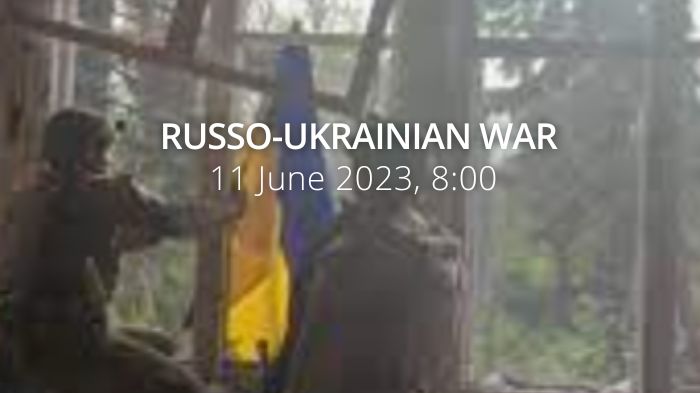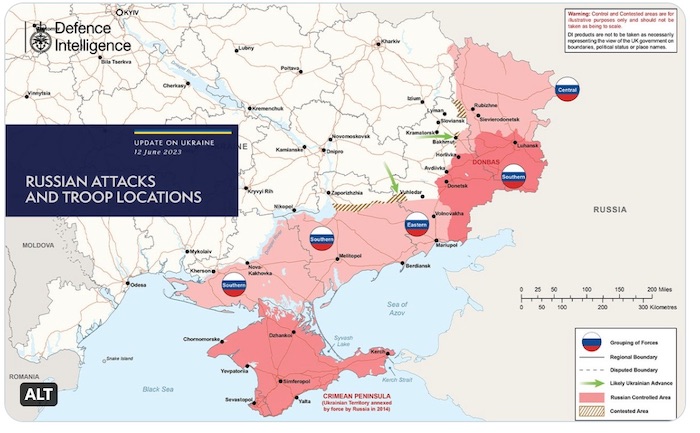Ukrainian forces made advances in western Donetsk Oblast and western Zaporizhzhia Oblast. Russian forces are transferring most combat-capable units from the Kherson direction to the Bakhmut and Zaporizhzhia directions. Russian forces conducted a limited series of drone strikes targeting the eastern Ukrainian border.
- Daily overview — Summary report, June 12
-
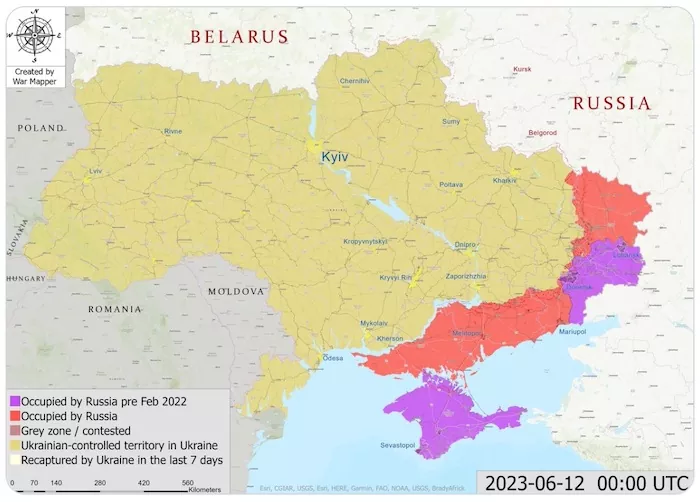
Source: War Mapper. - The General Staff’s operational update regarding the Russian invasion as of 18.00 pm, June 12, 2023 is in the dropdown menu below:
-
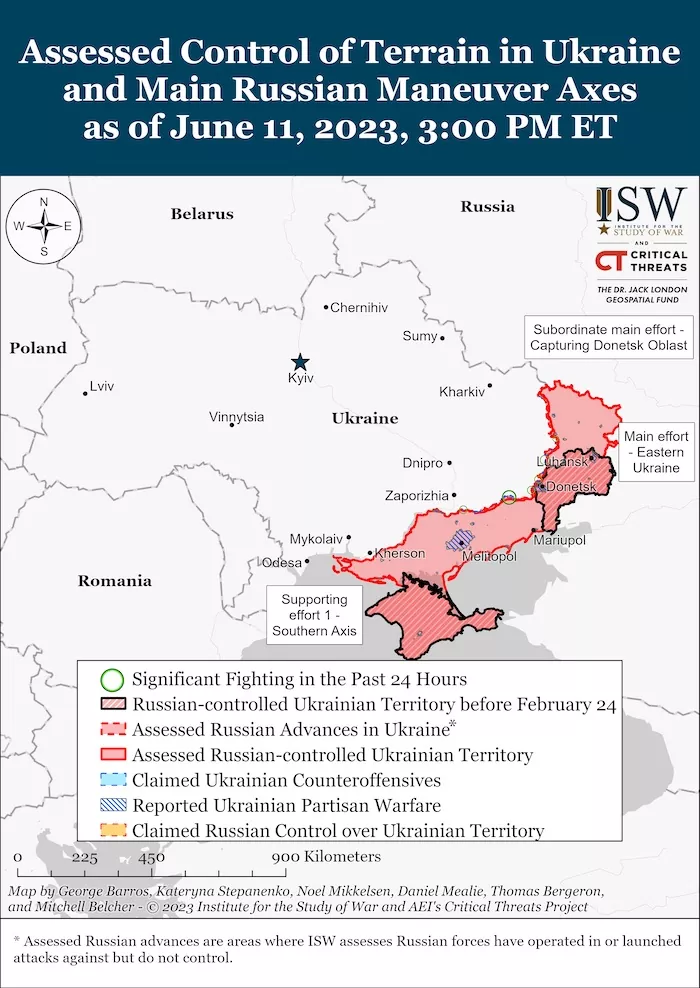
Situation in Ukraine. June 11, 2023. Source: ISW. - On June 11, the enemy launched 1 missile and 36 air strikes, 38 MLRS attacks at the positions of Ukrainian troops and various settlements. [Yesterday night, the Russian occupiers launched another massive airstrike against Ukraine, using Iranian strike UAVs of the "Shahed-131/136" type.]
- The likelihood of missile and air strikes across Ukraine remains high.
- The adversary focuses its main efforts on Lyman, Bakhmut, Avdiivka, and Mar’inka axes, and heavy fighting continues. On June 11, there were 25 combat engagements.
- Volyn and Polissya axes: [the operational situation has not changed significantly. There are no signs of the formation of offensive groupings. The Republic of Belarus continues to support the armed aggression of the Russian Federation against Ukraine, training of enemy units continues on its training grounds.]
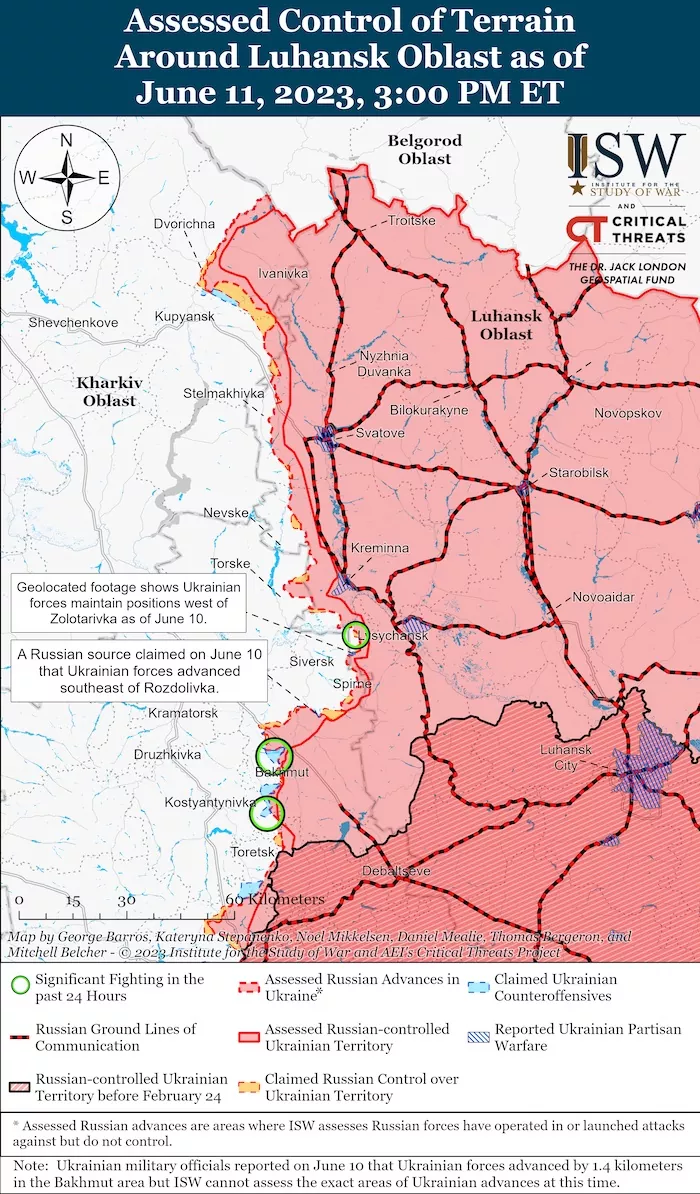
Luhansk Battle Map. June 11, 2023. Source: ISW. - Sivershchyna and Slobozhanshchyna axes: the adversary launched airstrikes on the settlements of Bilopillya (Sumy oblast) and Kolontaiv (Kharkiv oblast). The invaders fired mortars and artillery on the settlements of Seredyna-Buda, Fotovyzh, Bilopillya, Oleksandrivka (Sumy oblast), Ivashky, Veterynarne, Strilecha, Ternova, Starytsya, Hatyshche, Vovchans’k, Kruhle, Budarky, Buzove, Chuhunivka, and Ambarne (Kharkiv oblast).
- Kupiansk axis: Russian forces launched an airstrike in the vicinity of Berestove. The adversary fired artillery and mortars at Kam’yanka, Fyholivka, Dvorichna, Zapadne, Kyslivka, Tabaivka, Berestove (Kharkiv oblast), and Novoselivs’ke (Luhansk oblast).
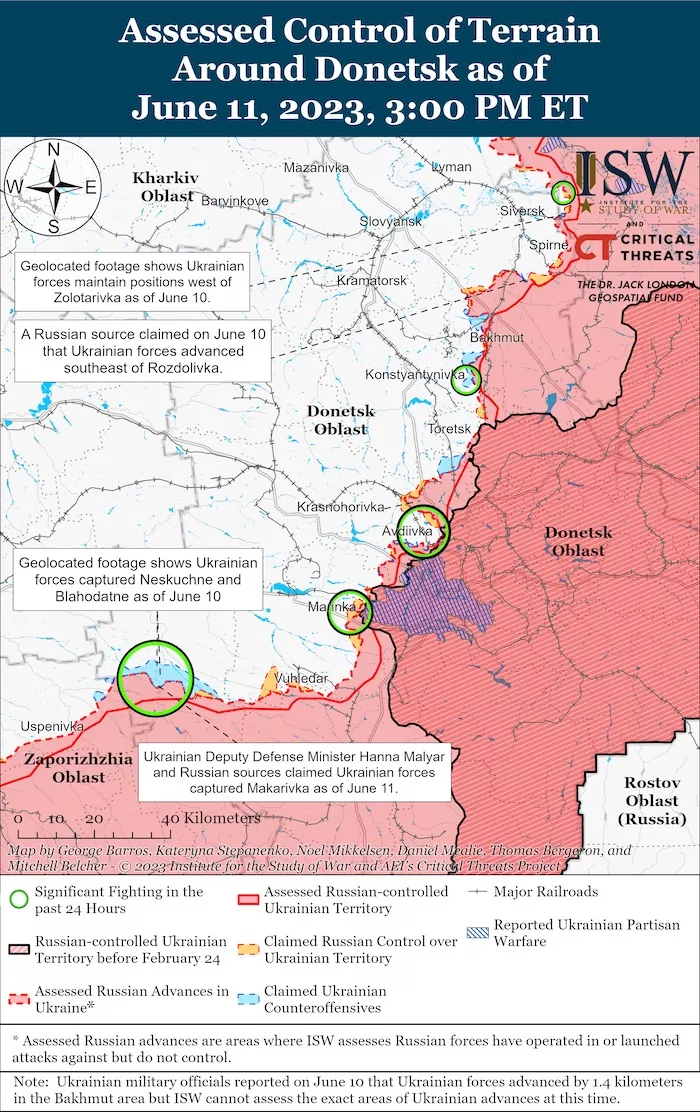
Donetsk Battle Map. June 11, 2023. Source: ISW. - Lyman axis: On June 11, the adversary conducted unsuccessful offensives in the vicinity of Bilohorivka. The invaders launched air strikes on the settlements of Nevske (Luhansk Oblast), Ivanivka, Tors’ke, and Serebryanka (Donetsk Oblast). Nevs’ke, Novoselivs’ke, Bilohorivka (Luhansk oblast), Yampolivka, Tors’ke, Verkhn’okam’yans’ke, and Spirne (Donetsk oblast) were shelled with artillery.
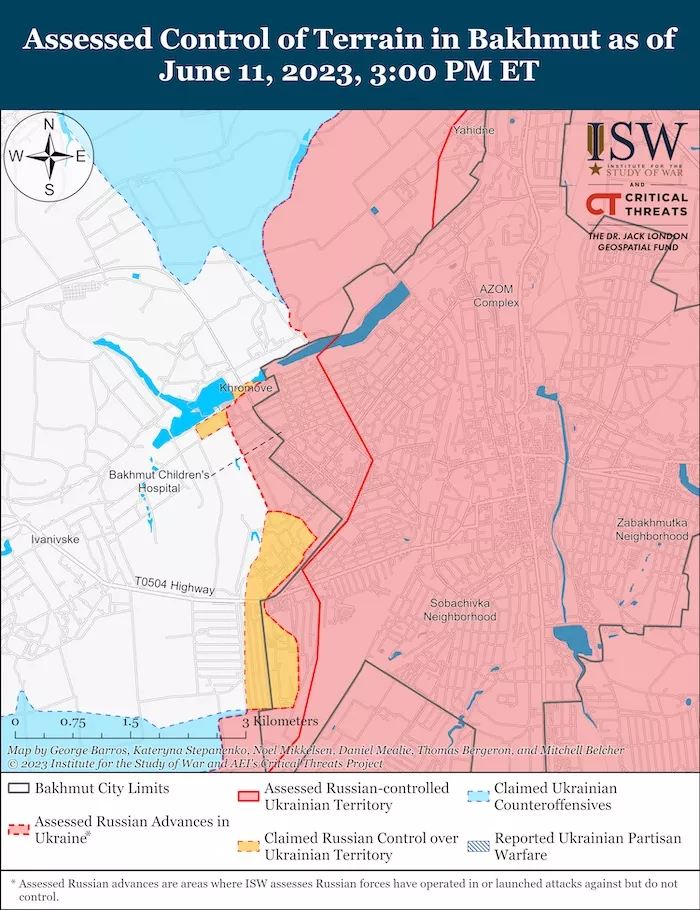
Bakhmut Battle Map. June 11, 2023. Source: ISW. - Bakhmut axis: the adversary attempted to improve its tactical situation, and conducted offensive operations towards Ivanivske and Bila Hora, to no success. Russian forces launched airstrikes in the vicinity of Toretsk. The enemy fired artillery at the vicinities of settlements of Razdolivka, Vasyukivka, Orikhovo-Vasylivka, Ivanivske, Bila Hora, Druzhba, Toretsk, Zalizne, and Pivnichne Donetsk oblast.
- Avdiivka axis: the enemy conducted offensive operations towards Avdiivka, to no success. The Russian forces launched airstrikes near Avdiivka and Nevelske. The invaders fired artillery at the vicinities of settlements of Orlivka, Avdiivka, Sjeverne, Pervomaiske, Karlivka, and Nevelske (Donetsk oblast).
- Marinka axis: Ukrainian defenders repelled all enemy attacks in the vicinity of the city of Marinka. At the same time, Krasnohorivka, Hostre, Heorhiivka, Mar’inka, Pobjeda and Novomykhailivka (Donetsk oblast) were shelled by the enemy artillery.
- Shakhtarske axis: the enemy launched airstrikes in the vicinities of Zolota Nyva, Blahodatne, Velyka Novosilka, and Neskuchne (Donetsk oblast). The invaders shelled Vodyane and Vuhledar.
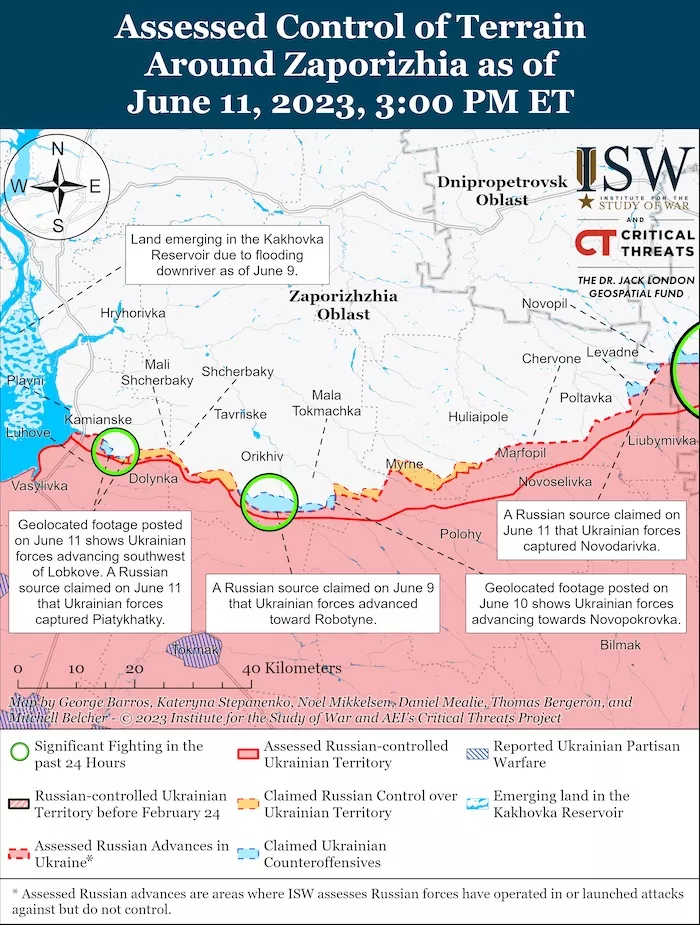
Zaporizhzhia Battle Map. June 11, 2023. Source: ISW. - Zaporizhzhia and Kherson axes: the adversary stays on the defensive. The invaders launched airstrikes in the vicinities of Novoberyslav and Kozats’ke (Kherson oblast). The adversary fired artillery at the settlements of Vremivka, Novosilka, Zelene Pole, Novopil’ (Donetsk oblast), Ol’hivs’ke, Malynivka, Hulyaipole, Zaliznychne, Huliaipilske, Bilohir’ya, Mali Shcherbaky, Stepove, Kam’yans’ke (Zaporizhzhia oblast), Kherson, and Ochakiv (Mykolaiv oblast).
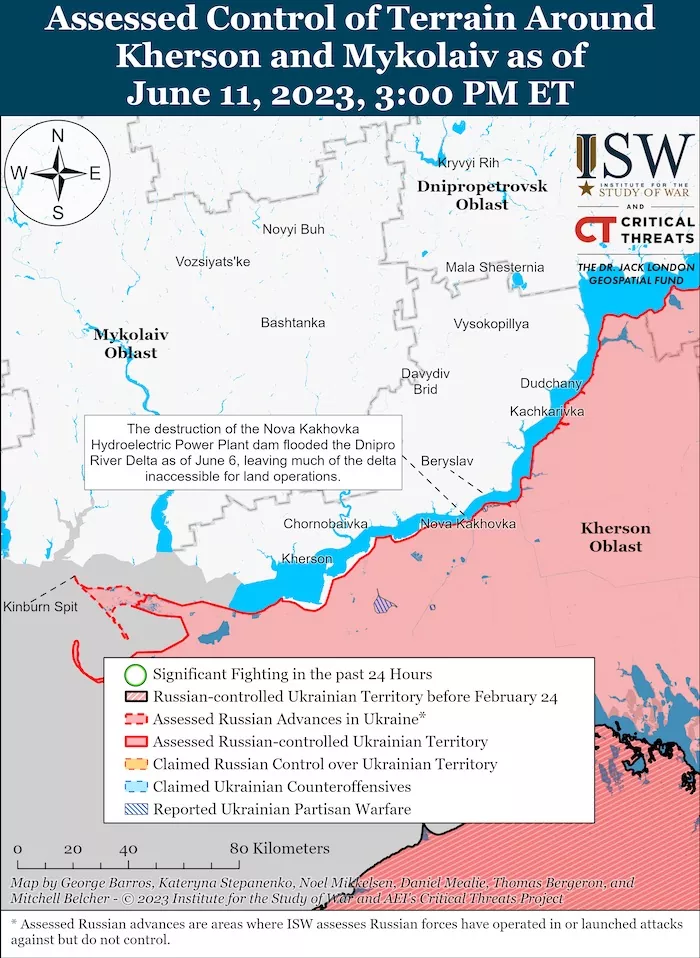
Kherson-Mykolaiv Battle Map. June 11, 2023. Source: ISW. - [Recently, among the mobilized personnel of the enemy, a depressed mood has been noted due to a lack of understanding of the tasks and goals of the so-called "special military operation". Also, the morale of the Russian occupiers is affected by the uncertainty of the terms of involvement in hostilities and stay in the armed forces.]
- [The Russian Federation continues to suffer significant losses in manpower. In particular, due to unsuccessful assault operations and attempts to improve their tactical position on the Bakhmut axis, many airborne troops were lost.]
- [The defence industry of the Russian Federation is being influenced by international sanctions. According to available information, large batches of 122 and 152 mm artillery ammunition produced in 2023 are prohibited for use due to their self-detonation. In addition, the deterioration of the level of provision of the occupiers' units with weapons and military equipment is noted.]
- Over the past week, Russian invaders have suffered significant losses on the Bakhmut axis. Thus, more than 50 occupants with severe injuries arrive daily at a military hospital in the vicinity of the settlement of Persianovka (Rostov oblast, Russia). The hospital is overcrowded and, the mortality rate in the seriously wounded is high due to the lack of sufficient medical staff.
- On June 11, the Ukrainian Air Force launched 6 air strikes on the concentrations of the adversary troops.
- At the same time, the Ukrainian missile and artillery troops hit 2 command posts, 2 artillery units at their firing positions and 1 radar station of the enemy.
- Military Updates
-
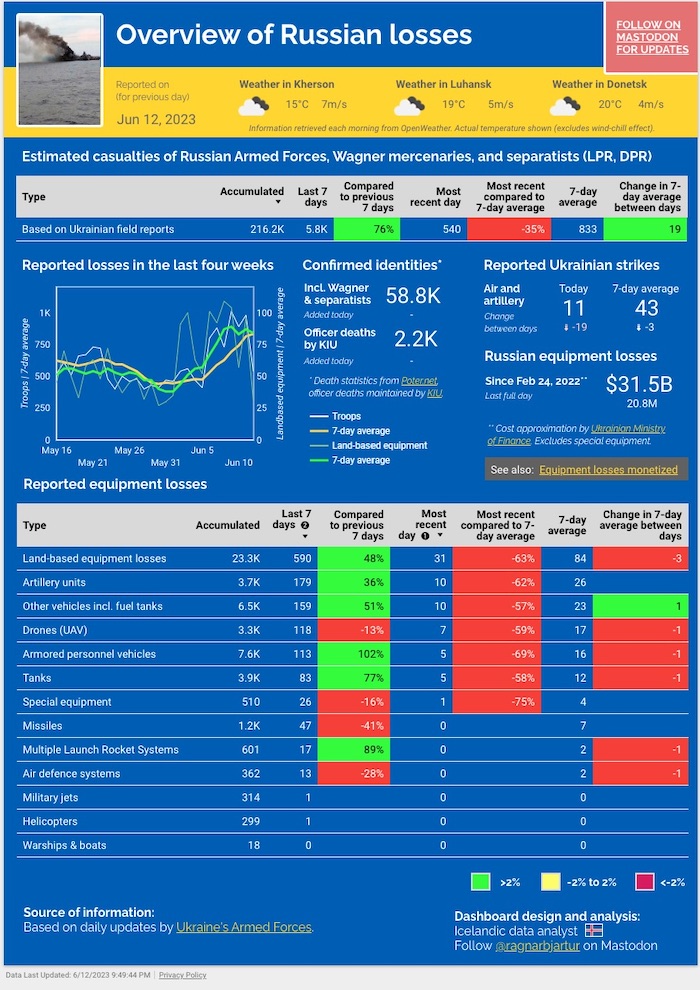
Shelling by Russian Troops. Icelandic Data Analyst. - Defence Forces revealed details of the liberation of Blahodatne: soldiers used ingenuity, Ukrainska Pravda reports. “Defence forces of the Tavriia front confirmed the liberation of the village of Blahodatne, Donetsk Oblast, on the border with the Zaporizhzhia Oblast, and reported the capture of six occupants.”
- Marines raise Ukrainian flag over Storozheve, Ukrinform reports. "The state flag is flying over Storozheve again, and this will happen in every settlement as we liberate all Ukrainian land. We thank the 35th Rear Admiral Mykhailo Ostrohradskyi Separate Marine Brigade," the joint press center of the defense forces of Tavria direction posted on Facebook.”
- Armed Forces of Ukraine liberate Makarivka and advance on several fronts – Deputy Defence Minister, Ukrainska Pravda reports, citing Hanna Maliar, Deputy Minister of Defence. "The fronts in which the offensive is carried out:
- On the Bakhmut front, our troops continue offensive actions. There is success in the area of the Berkhivka reservoir. We proceeded 250 metres. In the south there is progress on 2 fronts from 300 to 1,500 metres. The settlements of Blahodatne and Makarivka were de-occupied. Not a single position was lost on the fronts where our troops are on the defensive."
- Ukraine forces liberate Neskuchne in Donetsk region, Ukrinform reports. “The Armed Forces of Ukraine have gained control of the village of Neskuchne in Donetsk region. That’s according to a Facebook entry by the AREY 7th Separate Battalion Ukrainian Volunteer Army that’s part of the 129th Separate Brigade with the Territorial Defense Forces.”
- Trains stopped in Crimea, presumably due to explosion on railway, Ukrainian Pravda reports, citing Sergey Aksyonov, Head of the occupation authorities of the Russian-occupied Crimea and Baza Telegram channel. "Telegram channel Baza reports that an explosion occurred right in front of a train in Crimea.
- The locomotive driver, seeing an explosion on the railway, managed to pull the emergency brake in time. Glass shattered from the blast wave in the cockpit, the driver himself was not injured, reports the Telegram channel. The explosion on the railway in Crimea was reported by a number of Russian Telegram channels.”
- Partisans blow up railway bridge near occupied Melitopol, Ukrinform reports, citing Anatoliy Shtefan, an officer with Ukraine’s Armed Forces. “A railway bridge was blown up in the town of Yakymivka in the temporarily occupied area of Zaporizhzhia region by partisans from the city of Melitopol," the report says. It is noted that the bridge served as part of the enemy arms supply artery from the temporarily occupied Crimea to the temporarily occupied part of the Zaporizhzhia region. As reported earlier, explosions rang out in the temporarily occupied city of Berdiansk, near the local seaport.”
- Ukrainian air defence forces destroyed 6 "Shahed" overnight, Censor.net reports, citing the Ukrainian Air Forces. “The occupiers continue to attack Ukraine with Iranian-made Shahed-136/131 attack drones. On the night of June 11, 2023, frontline areas in Kharkiv and Sumy regions were attacked. According to preliminary data, six Iranian attack drones were destroyed by air defense in the area of responsibility of the Eastern Air Command, the statement said.”
- Iranian drones remain a problem for Air Force, - Ihnat, Censor.net reports, citing an іnterview with "Ukrainian truth" by Yuriy Ihnat, spokesman for the Ukrainian Air Force. “Russia deliberately launches these drones at night to deplete Ukrainian air defense. "Iranian drones are a headache. They are still difficult to shoot down. When there are a lot of them flying, they use different routes, they are pressed low to the ground, and it is difficult to reach them by plane. Because the speed of the drone itself is 150 km/h, and a fighter jet flies at least 400 km/h.
- We can't get this drone at night with the help of air defense systems of the ground forces or mobile fire groups, the statement said.”
- Russia says Ukraine tried to attack Russian ship in Black Sea, Reuters reports. “Russia said on Sunday that Ukraine had made unsuccessful attempt to attack a Russian naval ship with six high-speed drone boats as the Russian vessel patrolled major natural gas pipelines in the Black Sea. […]
- Ukraine attacked in the early hours of Sunday about 300 km south-east of Sevastopol, the headquarters of Russia's Black Sea fleet on the Russian-annexed Crimean peninsula, the defence ministry said.”
- According to British Defence Intelligence, (last 48 hours):
- Over the last week, Russian Defence Minister Sergei Shoigu has maintained a high public profile, likely with the aim of presenting himself as in control of strategic issues while Ukraine accelerates offensive operations.
- Shoigu has provided at least two comments on Russia’s defensive operations, including making almost certainly seriously exaggerated claims about Ukrainian losses. This contrasts with other key periods in the war when he had disappeared from public appearances.
- Shoigu has also urged Russia’s defence industry to redouble its efforts, and castigated Western Military District officers for not dispatching reserve armoured vehicles to the front quickly enough. Shoigu is likely acutely aware of the need to maintain a positive image in the face of increasingly unmasked criticism from some fellow Russians.
- The collapse of the Kakhovka Dam on 06 June 2023 has almost certainly severely disrupted the occupied Crimean Peninsula’s primary source of fresh water, the North Crimean Canal (NCC).
- The NCC draws water from the Kakhovka Reservoir, from an inlet higher than the bed of the reservoir. The water level in the reservoir had likely dropped below the level of the inlet by 09 June 2023 and water will soon stop flowing to Crimea.
- This will reduce the availability of fresh water in southern Kherson Oblast and northern Crimea. However, the Russian authorities will likely meet the immediate water requirements of the population using reservoirs, water rationing, drilling new wells, and delivering bottled water from Russia. Concurrently, communities on both the Russian and Ukrainian-controlled sides of the flooded Dnipro are facing a sanitation crisis with limited access to safe water, and an increased risk of water-borne diseases.
Losses of the Russian army
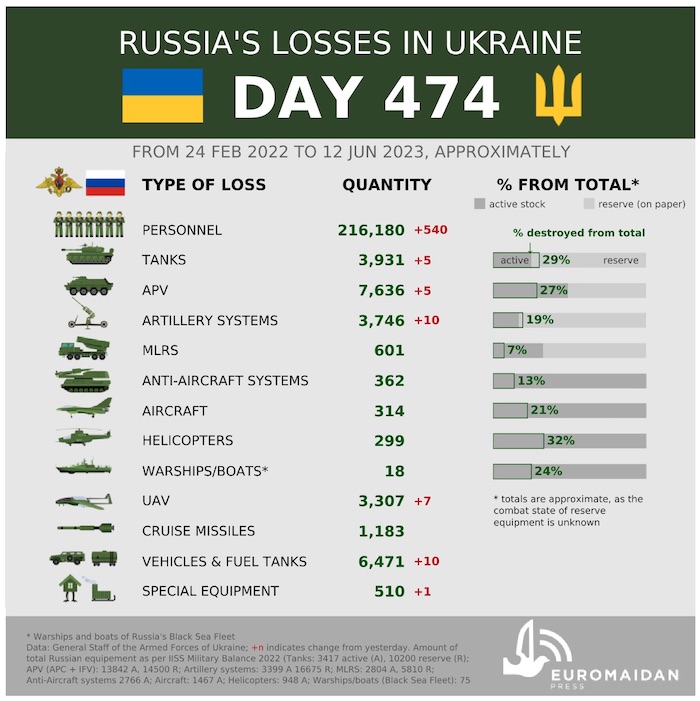
- Personnel – about 216180 (+540)
- Tanks – 3931 (+5)
- Armoured combat vehicles – 7636 (+5)
- Artillery systems – 3746 (+10)
- Multiple rocket launchers –MLRS - 601 (+0)
- Air defence means – 362 (+0)
- Aircraft - 314 (+0)
- Helicopters - 299 (+0)
- Automotive technology and fuel tanks – 6471 (+10)
- Vessels/boats - 18 (+0)
- UAV operational and tactical level – 3307 (+7)
- Special equipment – 510 (+1)
- Mobile SRBM system – 4 (+0)
- Cruise missiles – 1183 (+0)
Russia bans use of large quantities of ammunition due to self-detonation – General Staff, Ukrainska Pravda reports, citing report of the Ukrainian General Staff. "The defence industry of the Russian Federation is affected by international sanctions. According to available information, large batches of 122- and 152-mm artillery ammunition produced in 2023 are prohibited for use due to their self-detonation. In addition, there is a deterioration in the level of providing occupying units with weapons and military equipment.”
Russian Defence Minister forces all mercenary groups to sign contract with Russian MoD; Wagner Group's Chief refuses, Ukrainska Pravda reports, citing Russian MoD and Prigozhin's press service. “All Russian "military volunteer formations" will be forced to sign contracts with the Ministry of Defence. Meanwhile, Yevgeny Prigozhin, financier of the Wagner Private Military Company (PMC), says that the group's fighters will not do so.
Russia's Defence Minister Sergei Shoigu signed an order that will allegedly allow granting 'military volunteer formations' the necessary legal status. Russian authorities claim the state is concerned about social protection and support for these invaders. Under this decree, Wagner PMC is considered a military volunteer formation, and its participants must also sign a contract.
Prigozhin claimed that Shoigu's decrees apply to employees of the Russian Defence Ministry and that the Wagnerites would not sign contracts. Wagner PMC is organically integrated into the general system, Wagner PMC coordinates its actions with generals left and right, with unit commanders, it has deep experience and is a highly efficient structure. Unfortunately, most military units do not have such efficiency, and this is precisely because Shoigu cannot properly manage military formations…[ Prigozhin said]. As for what may happen after this order – we will not be given weapons and ammunition – we will find out, as they say, when the thunder strikes, they will come running and bring weapons and ammunition, begging for help.”
Lukashenka's regime supplied 131,500 tonnes of ammunition to Russia in one year, Ukrainska Pravda reports, citing MotolkoPomogi (MotolkoHelp), a project run by Belarusian journalist and analyst Anton Motolko. “In one year, the regime of self-proclaimed President of Belarus Aliaksandr Lukashenka has delivered 131,582 tonnes of ammunition to Russia. The Society of Railway Workers of Belarus has published data on the export of ammunition from the territory of Belarus to the Russian Federation and the temporarily occupied territories of Ukraine for the 13 months from January 2022 to February 2023.
The data indicates that the volume of ammunition exported during those 13 months amounted to 131,582 tonnes - an average of about 10,121 tonnes per month. The volumes were ten times smaller prior to Russia’s full-scale invasion of Ukraine and began to rise immediately after 24 February 2022. [….]
The stations to which the largest volumes were delivered were: Bryansk-Lgovsky (Bryansk, Bryansk Oblast) –25,022 tonnes; Tikhonky (Krasnodar Oblast) – 11,344 tonnes; and Alekseyevka (Alekseyevka, Belgorod Oblast) -–10,513 tonnes.
Ammunition was delivered to the following stations in occupied Crimea: Kirovska (3,335 tonnes), Solone Ozero (3,852 tonnes), Dzhankoi (561 tonnes) and Armiansk (1,800 tonnes). 7,768 tonnes of ammunition was also delivered to Lukovsky station in North Ossetia.”
Humanitarian
UN: Kakhovka HPP blast left 700,000 people without proper access to drinking water, Ukrinform reports. “After the Kakhovka dam blast, about 700,000 people do not have proper access to drinking water on both the Ukrainian-controlled and Russian-controlled sides of the river. UN Under-Secretary-General for Humanitarian Affairs Martin Griffiths said this in an interview with The Associated Press, Ukrinform reports.
According to him, there is also the flooding of important agricultural land and a looming problem of providing cooling water for the Zaporizhzhia nuclear power plant, Europe’s largest, which had been supplied from the dam. He stressed that the ravages of flooding will almost inevitably lead to lower grain exports, higher food prices around the world, and less to eat for millions in need.
Griffiths noted that waters also have rushed over areas with land mines from the war and what we are bound to be seeing are those mines floating in places where people don’t expect them, threatening adults and especially children. […]
According to him, the United Nations will launch a special appeal for more aid funds for Ukraine to deal with a whole new order of magnitude from the dam’s explosion. However, Griffiths said he wants to wait a few weeks to see the economic, health and environmental consequences before announcing the appeal.”
More than 23% of shelters in Ukraine unusable, Ukrinform reports. “As of June 10, 62,912 shelters have been inspected in Ukraine, more than 23% of which are unusable. This was reported by the State Emergency Service, according to Ukrinform. 9.3% were closed, 23.6% of the inspected shelters were unusable. 0.6% of the total number was not inspected due to hostilities, the report said.
According to the SES, 4,655 shelters were inspected in Kyiv. Of these, 0.6% were found to be closed, and 34.6% were unusable. Nearly two thousand groups consisting of representatives of local executive authorities, the SES and the National Police inspected shelters in Ukraine.
As reported, after three people died in Kyiv due to the inability to get to a shelter during enemy shelling, President Volodymyr Zelensky ordered a full audit of all defense structures in the capital and across the country.”
Details about those released: prisoners of the Wagner Group and Kadyrovites, those with unconfirmed status, Ukrainska Pravda reports, citing Coordination headquarters on the treatment of prisoners of war and the Security Service of Ukraine. “Among the 95 Ukrainian defenders released on Sunday's exchange, some were held captive by the Wagner Group and the Akhmat unit, and three were not officially confirmed as prisoners by Russians.
Among the 95 released from captivity – 51 representatives of the Armed Forces of Ukraine (including 15 territorial defence soldiers), 29 National Guardsmen, 11 border guards, and four military sailors.
All those released this time are men. Among them are two officers, the rest are private and non-commissioned officers. In particular, it was possible to return the defenders who were held captive by the Wagner Group and the Akhmat unit.”
Environmental
UN nuclear watchdog concerned over water levels at Ukraine plant, Reuters reports. “The UN atomic watchdog said on Sunday that it needs wider access around the Zaporizhzhia nuclear plant to check a significant discrepancy in water level data at the breached Kakhovka dam used for cooling the plant's reactors. International Atomic Energy Agency head Rafael Grossi, who is to visit the plant this week, said that measurements the agency received from the inlet of the plant showed that the dam's water levels were stable for about a day over the weekend.
However, the height is reportedly continuing to fall elsewhere in the huge reservoir, causing a possible difference of about two metres, Grossi said in a statement. The height of the water level is a key parameter for the continued operability of the water pumps.
The destruction of the Kakhovka hydropower dam in southern Ukraine last week has flooded towns downstream and forced thousands of people from their homes. Both the Kakhovka hydropower dam and the Zaporizhzhia nuclear plant have been occupied by Russia since the early days of its invasion in February 2022. The water from the reservoir is used to cool the facility's six reactors and spent fuel storage, the IAEA said. […]
Grossi said the thermal power plant "plays a key role for the safety and security of the nuclear power plant a few kilometres away," hence the need for access and independent assessment. The agency has said earlier that the Zaporizhzhia plant can fall back on other water sources when the reservoir's water is no longer available, including a large cooling pond above the reservoir with several months' worth of water.”
Occupiers blow up dam in Donetsk Oblast, causing flooding, Ukrainska Pravda reports, citing Valerii Shershen, the spokesperson for the Tavriia Front Defence Forces. “The Russian occupiers blew up a dam on the Mokri Yaly River in Donetsk Oblast, causing flooding on both sides of the river. […] The spokesperson explained that by blowing up hydroelectric facilities, the Russians are trying to slow down Ukraine's counter-offensive.
First, the occupiers blew up the Karlivka reservoir, then the Kakhovka Hydroelectric Power Plant, then they blew up other hydroelectric facilities in the occupied part of Zaporizhzhia Oblast. In Zaporizhzhia Oblast, they expected a breakthrough by the Defence Forces, so to slow down our advance, they resorted to this tactic when they blew up the hydroelectric facility on the Mokri Yaly River again. However, this has not affected the advance of the Defence Forces, said Shershen.”
Kakhovka Reservoir contaminated with UXOs – officials, Ukrinform reports, citing the Ministry of Internal Affairs. “The water area of the Kakhovka Reservoir is contaminated with unexploded ordnance and munitions, including those from the Second World War era - in one day alone, bomb squads made five controlled explosions.
The Ministry of Internal Affairs noted that explosive objects are a separate type of threat. Access to the banks is strictly prohibited for civilians, according to officials. In addition, the Ministry of Internal Affairs noted that due to constant shelling by Russian troops, the water area of the reservoir is contaminated with modern-era munitions.”
The situation in national parks is critical: Blowing up of Kakhovka HPP caused environmental damage of almost US$1,5 billion, Ukrainska Pravda reports. “Russia blew up the Kakhovka HPP, thus putting Kherson Oblast under threat of disappearance of 30% of its natural reserve fund. The approximate amount of damage to the environment due to the occupiers' blowing up of the Kakhovka HPP is almost US$1,5 billion, the Minister of Environmental Protection and Natural Resources of Ukraine, Ruslan Strilets, said.
Currently, the Kakhovka reservoir has lost 62% of its volume or 12.24 cubic kilometres of water. The water level in the reservoir is already at the 10.55m mark, and it continues to decrease, says the minister.
The situation in national parks is also critical. The occupiers caused damages of more than US$1,2 billion to the Nyzhniodniprovskyi National Park alone.The situation in the national parks is critical. 30% of the nature reserve fund of Kherson Oblast is in danger of disappearing. Water from the Kakhovka Reservoir has fashioned the Nyzhniodniprovskyi National Park into a water mirror.
There is ongoing draining of the water area in the national parks Velykyi Luh, by 4.2 metres, and Kamianska Sich by 6, the minister wrote on Facebook. The Oleshky Sands occupied by the Russians are threatened by rising groundwater. Also, about 1,200 hectares of the territory of the Kinburn Peninsula have been flooded due to the explosion of the Kakhovka HPP dam.
Environmental inspectors, national park workers, watermen and foresters at the site of the ecological disaster continue to record evidence of the occupiers' crimes.”
The agriculture losses from the Kakhovka HPP disaster may exceed $10B, and environmental damage already exceeds UAH 55B, Ukraine Business News reports, citing Minister of Environmental Protection, Ruslan Strilets. “The Ministry of Agrarian Policy thinks the farming, environmental and social spheres will suffer the most due to the lack of irrigation resulting from damage to the dam. As a result, 1-1.5 million hectares of farmland will not be fully used, and restoring irrigation systems will take three to seven years, said Minister Mykola Solskyi. According to Deputy Minister Taras Vysotskyi, direct and indirect losses in the agricultural sector may exceed $10B over five years.
In addition, the destruction of the Kakhovskaya HPP and the resulting flooding of the region will significantly affect the RES industry. According to the Association of Solar Energy calculations, the disaster may cause the removal of 500 MW of renewable energy generation in the Kherson and Mykolaiv regions from the power grid, including large hydropower. Particularly 334 MW of capacity from the Kakhovskaya HPP and more than 150 MW from solar power plants. At the same time, the restoration of the HPP itself and related infrastructure will cost Ukraine €2B.”
Legal
Russians fired at a boat with people evacuating from the left bank of Kherson Oblast: killing 3 and injuring 23, Ukrainska Pravda reports, citing the Head of the Office of the President Andrii Yermak; Head of Kherson Oblast Military Administration Oleksandr Prokudin and National Police of Ukraine. “Russian troops fired at a boat with civilians evacuating from the occupied left bank of Kherson Oblast, killing three people and wounding 23.
The National Police of Ukraine reported that 21 people were evacuated from the left bank of Kherson Oblast. 21 people barely got out of a deadly water trap on the occupied left bank. Almost all of them are elderly, with limited mobility. It was a big risk, but we could not leave people to their fate. As a result, they were attacked. Three civilians were killed. Ten people wounded, the message said.
The Kherson Oblast Prosecutor's Office reported that the Russian military fired on the civilian population during evacuation measures from flooded settlements in the temporarily occupied left bank part of Kherson Oblast on 11 June. As a result, three people were killed and at least 23 people were wounded. The information is being confirmed.”
Ombudsman: Russians use child labour, militarize children in captured territories, Ukrinform reports. “Russian aggressors use child labour and militarize minors in the temporarily captured territories of Ukraine. That’s according to the Verkhovna Rada Commissioner for Human Rights, Dmytro Lubinets, who reported the news on Telegram on World Day against Child Labor. He emphasized violations of children's rights in the temporarily occupied territories.
As Lubinets noted, the issues of combating child exploitation are defined by international and national legislative acts, which both Ukraine and Russia have ratified and committed to comply with. Among them is the UN Convention on the Rights of the Child, which defined, in particular, the right to protection from exploitation and work that may be harmful to the child; as well as the European Social Charter, which ensured children's rights to adequate education and social protection and set a minimum age for employment to limit access to hazardous forms of work; and Convention No. 182 of the International Labor Organization on the worst forms of child labor, ratified by Ukraine in 2000, which determined the need to combat slavery, sexual exploitation, involvement in armed conflicts, etc.
At the same time, the ombudsman said, today the Russian Federation ignores norms of international law. The Commissioner's Office regularly receives appeals from citizens from the temporarily occupied territories regarding the violation of their rights, including on the use of child labour and the militarization of children. Unfortunately, Ukraine does not have access to the temporarily occupied territories, so we are deprived of the opportunity to monitor the protection of children's rights in these territories. Millions of Ukrainians, including hundreds of thousands of children, remain beyond our country’s legal field, Lubinets emphasized.
On World Day against Child Labor, he appealed to the world to condemn Russia’s actions that violate the norms of international law. I urge you to support the Ukrainian Peace Formula in order to protect our children – their right to a happy childhood in a free and independent state, Ombudsman Lubinets emphasized.”
International Criminal Court begins investigation on destruction of Kakhovka HPP, representatives visit Kherson Oblast, Ukrainska Pravda reports, citing President Zelensky in his evening address. "During the last few days Kherson Oblast was visited by representatives of the International Criminal Court. On the first day after the disaster, the Prosecutor General sent an appeal to the Office of the Prosecutor of the International Criminal Court to investigate this disaster, and work has already begun.
It is very important that representatives of international justice saw firsthand the consequences of this Russian terrorist attack and heard for themselves that Russian terror continues. And it continues with the most cynical and cruel shelling of the flooded territory, the evacuation territory."
Support
Canada allocates $373M in military support and extends preferential trade for one year, Ukraine Business News reports. “Canadian Prime Minister Justin Trudeau announced CAD 500M in new support during his visit to Kyiv. The country will transfer 288 additional AIM-7 missiles for air defense, provide 10,000 105-mm caliber shells, and deliver 122 Roshel armored vehicles in addition to 88 such machines that have already been delivered to Ukraine. In addition, Canada will participate in training Ukrainian pilots on F-16 fighter jets and help organize the Leopard 2 maintenance center’s operation.
Trudeau also promised to increase sanctions pressure on Russia and will transfer the Russian An-124 transport plane to Ukraine, which was detained in Canada last year, and 24 individuals and 17 organizations will fall under the restrictions of a new sanctions package. The Prime Minister of Canada also promised an additional CAD 17.5M in financial assistance for the Kakhovka dam disaster. In addition, the Canadian government canceled all tariffs and quotas for Ukrainian products for one year.”
Details of ‘aircraft coalition’ to be discussed at Ramstein format meeting in June – Reznikov, Ukrinform reports. “First of all, we expect a similar level of support from our partners. During the meeting, we will discuss the details of the ‘aircraft coalition’. In this case, we are talking about the training of pilots and not only pilots but also our technicians and engineers who will deal with aircraft maintenance. Because this is a very complex system. The issue will be discussed meaningfully with the teams of the defense ministries of the Netherlands, Denmark, the USA, and other countries that have joined this coalition," Minister of Defense of Ukraine Oleksii Reznikov stated, Ukrinform reports with reference to the Ministry of Defense. […]
Then everything related to air defense, ammunition, artillery [will be discussed]. Our priorities have not changed. This war is a war of resources. Resources are not only weapons but also the ability to repair and maintain them and everything related to this. Therefore, the opening of various types of hubs for repairing and maintaining equipment is important to us. Both in the territory of Ukraine, together with partners, and in friendly bordering countries, the minister summed up.
As reported, the next Ukraine Defense Contact Group meeting will take place on June 15.”
Ukrainian pilots “pumped” for F-16 training, Ukrinform reports, citing the spokesman for Ukraine’s Air Force Command, Yuriy Ihnat said this in an interview with the Ukrainian Pravda. “No, not yet,” he said, answering a question of whether the training on F16 fighter jets has already kicked off for Ukrainian pilots.
Our pilots, as they say, are all pumped. The first group of the best pilots has been selected - those who have combat experience, who have hundreds of flight hours behind their back, those who speak English, the young ones. The list is being updated, some pilots even get killed in action. But you need to understand that the best of the best will be the first to go. We are all looking forward to this, said Ihnat. According to him, it will take up to six months for Ukrainian pilots to master the warplane.”
Ukraine to receive NATO accession algorithm at Vilnius summit – Ukraine's Defence Ministry, Ukrainska Pravda reports, citing Ministry of Defence of Ukraine. “Volodymyr Havrylov, Deputy Minister of Defence of Ukraine, is convinced that the NATO summit in Vilnius will establish the algorithm for the country's accession to the Alliance. Havrylov noted that at the summit in July, NATO countries "will agree on a certain procedure for our accession, which will be established".
He added that despite the consensus mechanism of decision-making and the right of veto of the member countries of the Alliance, he does not think that there will be big problems" with making a decision on Ukraine. There are all signs that Ukraine will get what it wants in a certain format, Havrylov said. Even now, at the summit in Vilnius, Ukraine must clearly understand that after the war, say within a year or two, after carrying out certain procedural things, we will be members of NATO, the deputy minister added.
As reported, Ukraine wants to accede to the North Atlantic Treaty Organization soon after securing a military victory over Russia, and hopes to receive guarantees that this will happen during the NATO summit in Vilnius. Earlier, President Volodymyr Zelenskyy said that he understood that Ukraine would be unable to join NATO while the war was ongoing, but he sees no point in attending the NATO summit in Vilnius if, as a result, Ukraine does not receive specific signals on when it can join the Alliance.”
New Developments
- Occupiers blow up dam in Donetsk Oblast, causing flooding, Ukrainska Pravda reports, citing Valerii Shershen, the spokesperson for the Tavriia Front Defence Forces. “The Russian occupiers blew up a dam on the Mokri Yaly River in Donetsk Oblast, causing flooding on both sides of the river. […] The spokesperson explained that by blowing up hydroelectric facilities, the Russians are trying to slow down Ukraine's counter-offensive.”
- Russia able to produce missiles by circumventing sanctions, Ukrinform reports, citing the Ukrainian Air Force spokesman Yurii Ihnat in an interview with the Ukrainska Pravda. "Unfortunately, Russia receives components. Unfortunately, it continues production. The enemy did not have enough high-precision, long-range missiles - Kh-101, Iskander-M, Iskander-K, Kalibr, Kinzhal – that can reach [targets] far inside the country and strike accurately. When they attacked our critical infrastructure, they used virtually all of their potential of this strategic weaponry. But in the spring there was a short pause, when the enemy increased production. And according to new data from the Main Intelligence Directorate, they already have more Kinzhals and Kalibrs, he said. In his opinion, Russia has obviously found an opportunity to circumvent sanctions at the expense of individual countries that cooperate with it and receives technological things that it cannot manufacture itself: circuit boards, chips, semiconductors.”
- Canada becomes 20th country to declare support for Ukraine's NATO membership, Ukrinform reports, citing Deputy Head of the President’s Office Ihor Zhovkva. “The joint declaration clearly records Canada’s support for Ukraine's acquisition of NATO membership as soon as conditions allow. This is the strongest wording among all the G7 countries that are NATO members. Canada also supports the creation of the Ukraine-NATO Council instead of the corresponding Commission – and this is the first such public support for the new mechanism of interaction between Ukraine and the Alliance, official said. Zhovkva emphasized that only 10 days have passed since the summit of the European Political Community in Moldova, where a joint declaration was signed with Romania, concluding that currently, 20 states have formalized their support for Ukraine's membership of the Alliance. […]”
- European Commission cancels ban on import of 12 groups of goods from Ukraine, Ukrinform reports, citing Suspilne. "We believe that the European Commission listened to us on June 5, when the restrictions were extended, they were extended only for six types of products and canceled for the other 11 or 12 groups of products," Deputy Prime Minister for European and Euro-Atlantic Integration of Ukraine Olha Stefanishyna said. She noted that the physical blockade on Poland–Ukraine border has been lifted and Ukraine will be able to transport products through Poland to other countries.”
Assessment
- On the war.
The Institute for the Study of War has made the following assessment as of June 11, 2022:
Russian forces continued limited ground attacks south of Kreminna on June 11. The Ukrainian General Staff reported that Ukrainian forces repelled Russian offensive operations near Bilohorivka (12km south of Kreminna). A Russian milblogger claimed that the Russian forces are engaged in heavy fighting near the settlement. Russian milbloggers claimed that Russian forces conducted unsuccessful ground attacks near Vesele (30km south of Kreminna). […]
Ukrainian and Russian forces continued limited ground attacks around Bakhmut on June 11. Russian milbloggers claimed that Ukrainian forces attacked near Klishchiivka (7km southwest of Bakhmut), and that Russian Spetsnaz units are trying to push Ukrainian forces from positions near Klishchiivka. A milblogger claimed that Russian forces repelled two Ukrainian attacks in the Soledar-Bakhmut direction. A Russian milblogger claimed that Russian forces conducted failed ground attacks near Bohdanivka (5km northwest of Bakhmut). The Ukrainian General Staff reported that Ukrainian forces repelled a Russian ground attack near Bila Hora (14km southwest of Bakhmut).
Ukrainian forces made marginal gains near Avdiivka as Russian forces continued limited ground attacks on the Avdiivka-Donetsk City line as of June 11. Geolocated footage shows that Ukrainian forces made marginal advances south of Nevelske (13km southwest of Avdiivka) as of June 11. […] A Russian source claimed that Ukrainian forces conducted counterattacks near Sieverne (6km west of Avdiivka) and Opytne (3km southwest of Avdiivka) on June 10. A Russian milblogger claimed that Russian forces conducted a failed ground attack near Sieverne on June 11. The Ukrainian General Staff reported that Ukrainian forces repelled Russian ground attacks near Avdiivka and Marinka. Footage published on June 11 indicates that the Russian 10th Tank Regiment (3rd Army Corps, Western Military District) continues to operate near Avdiivka.
Ukrainian forces conducted counteroffensive operations in at least three areas of the front and made territorial gains on June 10 and 11. Ukrainian Deputy Defense Minister Hanna Maliar reported that Ukrainian forces are conducting offensive operations in the Bakhmut area, and Russian sources reported continued Ukrainian ground attacks on Bakhmut’s northern and southern flanks. Geolocated footage and Russian sources indicated that Ukrainian forces liberated multiple settlements during continued ground attacks south, southwest, and southeast of Velyka Novosilka in western Donetsk Oblast. Russian sources reported that Ukrainian forces continued to attack southwest of Orikhiv in Zaporizhzhia Oblast, and Ukrainian forces made gains in this area.
Ukrainian forces made visually verified advances in western Donetsk Oblast and western Zaporizhzhia Oblast, which Russian sources confirmed but sought to downplay. Ukrainian Deputy Defense Minister Hanna Maliar reported that Ukrainian forces advanced 300 to 1,500 meters in southern Ukraine. Maliar and other Ukrainian and Russian sources reported that Ukrainian forces made gains south of Velyka Novosilka between June 10 and 11, including liberating Makarivka, Neskuchne, Blahodatne, Storozheve, and Novodarivka. Some Russian sources reported that battles are ongoing in “grey zone” or contested areas or that Ukrainian forces are operating in areas that Russian forces did not fully occupy before Ukrainian attacks in southern Ukraine. Russian sources are likely referring to Ukrainian territorial advances through Russian defenses as capturing ”grey zones” in order to downplay Ukrainian gains and omit reporting on Ukrainian forces breaking through defensive lines. Ukrainian forces liberated several towns, but claims of a Ukrainian “breakthrough” are premature at this time.
Ukrainian Deputy Defense Minister Hanna Maliar stated that Russian forces are transferring their most combat-capable units from the Kherson direction to the Bakhmut and Zaporizhzhia directions. Maliar stated on June 11 that Russian forces are transferring elements of the 49th Combined Arms Army (Southern Military District) and unspecified naval infantry and airborne forces elements from the Kherson direction in connection with the destruction of the Kakhovka Hydroelectric Power Plant (KHPP) dam. Maliar noted that Russian forces likely blew the KHPP dam in order to shorten their defensive lines in Kherson Oblast as part of the response to the start of the Ukrainian counteroffensive. Flooding downriver of the KHPP has drained the Kakhovka Reservoir, resulting in landmasses emerging from the water. It is unclear how these terrain changes will affect maneuver warfare in southern Ukraine at this time. If the terrain changes from flooding in the Dnipro River do not foreclose any possible Ukrainian river crossings in coming weeks and months, Russian forces may struggle to defend Kherson Oblast with remaining or then-available units if, and when Ukrainian forces choose to conduct offensive operations across the river, assuming they have the ability to do so.
Russian forces conducted a limited series of drone strikes targeting eastern Ukrainian border areas overnight on June 10 to 11. Ukrainian officials reported that Ukrainian forces shot down six Russian Shahed drones that targeted border areas in Sumy and Kharkiv oblasts overnight. Ukrainian Air Force Spokesperson Colonel Yuriy Ihnat noted that Russian forces are working to produce more high-precision, long-range ballistic missiles and stated that Ukraine’s stock of Western air defense systems is currently insufficient to replace its stock of Soviet air defense systems.
Wagner financier Yevgeny Prigozhin characterized the Russian Ministry of Defense’s (MoD) plan to formalize volunteer formations by July 1 as an attack on him and his forces. Russian Defense Minister Sergei Shoigu announced on June 10 that all volunteer formations must sign military contracts with the Russian MoD by July 1. Prigozhin defensively claimed that Wagner private military company’s (PMC) servicemen will not sign contracts with the Russian MoD in his media response to Shoigu’s announcement. Prigozhin proceeded to criticize Shoigu and the structure of the Russian Armed Forces and specified that Wagner is entirely subordinate to the interests of Russia and Russian President Vladimir Putin. Prigozhin’s mention of Putin as the Supreme Commander-in-Chief closely mirrors the language Chechen leader Ramzan Kadyrov used in his accusation on June 9 that Prigozhin is being insubordinate to Putin. Prigozhin also noted that Wagner approves its actions with the Russian military command via Wagner-affiliated Army General Sergei Surovikin.
Some members of Russia’s veteran community indicated Shoigu’s statement is not intended to target Wagner. A member of the Russian State Duma Defense Committee (and former commander of the 58th Combined Arms Army) Viktor Sobolev stated that Shoigu’s order excludes Wagner. Sobolev is an avid critic of Wagner and claimed that Wagner personnel are mercenaries, not volunteers. Former Russian officer and ardent ultranationalist Igor Girkin supported the order and stated that cohesive armies win wars rather than separate detachments or private military companies (PMCs). A Wagner-affiliated milblogger contrarily (baselessly) claimed that Wagner is not a PMC and that a secret decree legalized Wagner’s existence in Russia. The milblogger also claimed that Shoigu and the Russian MoD are Girkin’s patrons who are using Girkin to prevent Prigozhin from assuming more authority and reshuffling leadership in the Russian MoD.
Russia and Ukraine conducted a near one-for-one prisoner of war (POW) exchange on June 11. The Russian Ministry of Defense (MoD) claimed that Ukraine returned 94 Russian POWs of unspecified ranks to Russia. Ukrainian Presidental Office Head Andriy Yermak reported that Russia returned two Ukrainian officers and 93 privates and sergeants to Ukraine.
Key Takeaways
- Ukrainian forces conducted counteroffensive operations in at least three areas of the front and made territorial gains on June 10 and 11.
- Ukrainian forces made visually verified advances in western Donetsk Oblast and western Zaporizhzhia Oblast, which Russian sources confirmed but sought to downplay.
- Ukrainian Deputy Defense Minister Hanna Maliar stated that Russian forces are transferring their most combat-capable units from the Kherson direction to the Bakhmut and Zaporizhzhia directions.
- Russian forces conducted a limited series of drone strikes targeting eastern Ukrainian border areas overnight on June 10 to 11.
- Wagner financier Yevgeny Prigozhin characterized the Russian Ministry of Defense’s (MoD) plan to formalize volunteer formations by July 1 as an attack on him and his forces.
- Russia and Ukraine conducted a near one-for-one prisoner of war (POW) exchange.
- Russian forces continued limited ground attacks south of Kreminna.
- Ukrainian and Russian forces continued limited ground attacks around Bakhmut and on the Avdiivka-Donetsk City line.
- Ukrainian forces made gains near the administrative border between Donetsk and Zaporizhzhia oblasts and in western Zaporizhzhia Oblast as of June 10.
- Russian milbloggers claimed that rain along the Zaporizhzhia Oblast front may slow Ukrainian operations in the coming days.
- The Republic of Chechnya reportedly formed two new regiments – Akhmat-Russia and Akhmat-Chechnya – equipped with commercially-available Chinese armored equipment.
Saboteurs, reportedly including Ukrainian partisans, conducted two discrete improvised explosive device (IED) attacks against railways in occupied Kherson Oblast and Crimea.
Russian forces in Zaporizhzhia Oblast are continuing to defend against Ukrainian attacks in accord with sound tactical defensive doctrine, ISW reported on 10 June. A Russian milblogger claimed that Russian defensive operations in southern Ukraine are relying on three main components: early detection and destruction of Ukrainian assault formations, massive use of anti-tank weapons, and mining of territories near Russian defensive positions. The milblogger claimed that minefields have a twofold effect by initially damaging Ukrainian armored vehicles when they attempt to breakthrough the minefield and then again when they retreat from the area.
ISW previously assessed that Russian forces responded to the start of Ukrainian counteroffensive operations in western Zaporizhzhia Oblast following established Russian doctrine, which calls for a first echelon of troops to repel or slow attacking forces with minefields, fortifications, and strongpoints, and a second echelon of forces to counterattack against any enemy breakthrough. […]
Russian milbloggers continue to highlight reported superior Russian electronic warfare (EW) capabilities as key to disrupting Ukrainian attacks. Russian milbloggers claimed that Russian EW units are disrupting Ukrainian communications as well as aviation units and alleged that some Ukrainian mechanized groups were not prepared to fight without communications or with suppressed GPS. Another milblogger claimed that Ukrainian forces attempted their own “electronic counter measures” against Russian reconnaissance and control capabilities in areas where there are Ukrainian assaults but that these attempts were unsuccessful. Russian forces have reportedly successfully improved their EW use throughout the invasion of Ukraine.
Russian sources claimed that Ukrainian forces have tactical advantages in conducting assaults at night due to Western-provided equipment with superior night optics systems. A prominent Russian milblogger claimed that Ukrainian forces are launching assaults at night because Western-provided equipment provides Ukrainian forces with “excellent” night vision optics. […] Russian sources have widely claimed that Ukrainian forces have started or intensified assaults at night in recent days, and Ukrainian forces may be increasingly leveraging the advantages provided by Western systems.
Russian sources continue to highlight the role of scarce military district-level Russian TOS-1A thermobaric artillery systems against Ukrainian attacks, though Ukrainian forces destroyed at least two of these key systems in recent days. Geolocated footage published on June 8 and 9 confirms that Ukrainian forces have used Western precision munitions (reportedly the Paladin 155mm artillery system) to destroy at least two Russian TOS-1A thermobaric artillery systems – highly destructive but scarce artillery assets controlled at the Russian military district level – in western and eastern Zaporizhzhia Oblast during the Ukrainian counteroffensive. […] A Russian milblogger claimed that Russian thermobaric artillery units have consistently fired on Ukrainian forces on the Donetsk-Zaporizhzhia Oblast administrative border and in western Zaporizhzhia Oblast for the past several days and characterized the units as essential to repelling Ukrainian frontal assaults. Russian forces’ apparent reliance on specific artillery assets is noteworthy, as precision Ukrainian strikes on these systems could potentially complicate Russian defensive capabilities and Russian forces are unlikely to possess enough TOS-1A systems to provide the same level of fire support all along the front line.
Ukrainian forces are currently attempting an extraordinarily difficult tactical operation – a frontal assault against prepared defensive positions, further complicated by a lack of air superiority – and these initial assaults should not be extrapolated to predict all Ukrainian operations. Ukrainian forces are unsurprisingly taking casualties in initial attacks against some of the best-prepared Russian forces in Ukraine. However, initial attacks – and particularly selected footage that Russian sources are intentionally disseminating and highlighting – are not representative of all Ukrainian operations. The Russian military remains dangerous and Ukrainian forces certainly face a hard fight, but Ukraine has not yet committed the vast majority of its counteroffensive forces and Russian defenses are not uniformly strong along all sectors of the front line.”
- Consequences and what to do?
The West isn’t ready to give Ukraine the security pledges it wants, Politico reported on 8 June. “Ukraine is pleading for binding security guarantees to ensure long-term survival. Allies just aren’t ready to do that yet. Despite months of conversations about the subject, the Western alliance is still divided over nearly every element of how to respond to the request, according to five European diplomats. Should NATO, which Ukraine is aspiring to join, be having that conversation? Or should the world’s biggest military powers provide individual pledges? Are any guarantees short of NATO membership worthwhile? And, officials are wondering, what even constitutes a “security guarantee”?
All these questions remain open, the diplomats said, even as allies are only five weeks away from gathering in Vilnius for a key NATO summit. Ukraine has set the summit as a sort of deadline, pushing for allies to make explicit commitments at the gathering about letting Ukraine into NATO and providing security guarantees along the way. Ukraine is the most experienced country in the world in hearing ‘no’ from NATO, lamented Ukrainian Deputy Prime Minister for European Integration Olha Stefanishyna. We need clarity, she added, that Ukraine’s NATO membership is inevitable and will not be some kind of bargain chip.
Kyiv’s backers are thus grappling with an awkward reality: many don’t actually want to give Ukraine a concrete timetable for joining NATO at the moment. But they also don’t want to leave Ukrainians disappointed or vulnerable to yet another invasion down the line. As a result, a number of Western European leaders are increasingly stumping for security guarantees and offering more upbeat language about membership. But underneath the rhetoric, the actual planning is muddled — a reflection of the difficulty of getting a diverse group of governments on the same page as fighting rages on the ground in Ukraine. […]
Ukraine wants NATO leaders to give Kyiv a roadmap to accession for after the war — and concrete security guarantees from Western capitals in the meantime. A number of Western leaders in recent days have at least paid lip service to the need for security guarantees.
French President Emmanuel Macron backed something between Israel-style security guarantees and fully-fledged [NATO] membership, referencing the dedicated military aid allies have funneled to Israel for years. And British Prime Minister Rishi Sunak added his own vague commitment, saying allies want to make sure that we put in place security arrangements for Ukraine for the long term.
But current and former officials say there is no consensus on giving guarantees — nor on what they would entail and what format could be used. At one end of the spectrum, said Camille Grand, a former NATO assistant secretary general, is full NATO membership. This option brings with it the ironclad Article 5 guarantee — that an attack against one ally is considered an attack against all allies. At the other end of the spectrum, he noted, are what can be considered “paper guarantees,” such as the weak 1994 Budapest Memorandum that gave Ukraine loose assurances from Russia, the US and the U.K. In between, he said, there are many variants — from bilateral treaties to de facto political commitments — and the challenge is to find the right spot.
One proposal on the table is the so-called Kyiv Security Compact, a concept Ukrainian President Volodymyr Zelenskyy’s office developed with former NATO Secretary-General Anders Fogh Rasmussen. That plan would see a core group of allies make binding commitments to fortify Ukraine’s defenses for years to come with both military and non-military aid.
Separately, a group of former senior Western defense officials and academics have also put forward an idea focused on long-term cooperation and helping Ukraine rapidly expand its own defense industry. It would be similar to the US defense commitment to Israel, said Alexander Vershbow, a former senior US official who also served as NATO deputy secretary general. And it would serve as an “interim” arrangement until Ukraine joins NATO, he added at a conference in Brussels on Tuesday.
Yet officials say that when politicians now talk about “guarantees” and “assurances,” they are essentially talking about pledges to keep the weapons and training coming — not concrete promises to come to Ukraine’s defense. More often we hear of assurances, rather than guarantees, said a senior diplomat from Central Europe. It all seems to come down to long-term provision of means to be able to defend themselves. A Western European diplomat agreed: Many of us prefer to talk about ‘security assurances. Promises for just more weapons, however, aren’t exactly what Ukraine wants.
Instead, Zelenskyy’s mounting pleas — including during an in-person appearance before European leaders in Moldova — have been for unbreakable pledges that are a stepping stone to NATO. Stefanishyna, Ukraine’s deputy prime minister, specified that Ukraine envisions something like the military commitments Finland and Sweden received after submitting their own NATO bids in the weeks following Russia’s invasion. […]
Diplomats are divided on whether guarantees — or assurances — should be part of NATO’s conversation about Ukraine’s bid. Thus far, most people tracking the discussions say the debate around guarantees will most likely take place outside the NATO framework. NATO security guarantees are Article 5, is full membership, alliance chief Jens Stoltenberg said on Wednesday when asked about potential guarantees for Ukraine. I know, he added, that there are also discussions and consultations between Ukraine and some allies on bilateral arrangements.
But even if the issue is not formally on NATO’s agenda, the guarantee debate is now on everyone’s minds as the allies prepare for their July summit. Regardless of whether [guarantees] are mentioned in the NATO communiqué or not, practically they will have an indirect impact on the alliance, said the senior diplomat from Central Europe, so pushing this issue out and pretending this is not a NATO issue, is not helpful.
For some officials, the debate over security assurances is a distraction from the one guarantee they say actually matters: eventual NATO membership. Is any country seriously considering to provide genuine bilateral security guarantees to Ukraine? Only Article 5 guarantees matter, said the first diplomat from Eastern Europe. Long-term arms deliveries, this diplomat argued, are not a security guarantee.”
Hans Petter Midttun: During the first eight years of the war, the West did not act in a manner that surprised or shook Russia. We followed the long-established script of appeasement and negotiations trying to find a political solution while Russia used its complete toolkit – including military power – as a part of a long-term effort to destabilise and subjugate Ukraine. The military options were off the table nearly before the war started on 20 February 2014.
After 15 years of not responding to Russian provocations and transgressions of International Law – including its war on Georgia and Ukraine - the Western response to its full-scale invasion came as a surprise. The massive defence support, financial and humanitarian aid as well as comprehensive, cross-sectorial sanctions must have shaken Putin and the Russian elite.
A little bit, at least.
While all the above support is massive compared to what was provided in the first eight years of the war, it still arrives “too little, too late” implying elements of appeasement.
Despite the war affecting the security and stability of NATOs member states; despite Russia’s attempt to restructure the international security structure that is the basis for Western stability and prosperity; despite the hybrid war Russia is waging against the West; despite the “tsunami of ripple effects from the war” threatening to change the political landscape in both the US and Europe; despite its ultimatums against both the USA and the individual NATO members as of 17 December 2021 meant to re-establish a sphere of interest covering all countries joining NATO since 1997; and despite its imperialistic nature and global power ambitions at the cost of its neighbours – and our common security and stability – despite all of that: NATO has only been able to agree that it is no longer at peace.
It is still seen as weak, afraid, uncommitted, and shortsighted.
While the Western actions during the first weeks following the start of the full-scale war came as a surprise (and the surprise being a testimony to the failure of diplomacy), the West has still failed to meet Russia on equal terms.
NATO has failed to acknowledge being under assault (which the EU has long recognised) over concern that it will need to act upon the assessment. Western slow and incremental defence support is not setting up Ukraine for victory. It has still failed to provide Ukraine with F-16 and ATACMS. Many are still denying it the opportunity to target the weapon carriers operating on or over Russian territory. The Alliance has failed to defend the universal Freedom of Navigation. It has failed to establish a unified end state, strategy, and red lines. The West has not least, refused to counter Russian military power with military power.
Despite Russia’s ever-increasing atrocities – in which the destruction of the Kakhovka Dam is just the latest in a series of horrendous war crimes – the West is still unable to cry ENOUGH ALREADY and do what is needed to end the war.
Russia will continue to escalate as long as the international community fail to stop it. In the absence of resolve, we will be seen as weak and divided.
This leads me to the question in the back of my mind: Have the West made any fundamental changes to its strategy towards Russia since 2007?
That’s not to acknowledge the tremendous support rendered. The defence, humanitarian, and financial support is tremendous (but not unprecedented). But it is still doing the same as we did during the first eight years at a bigger scale and scope.
Russia has become the most sanctioned country in the world. Admittingly, the sanctions come at high costs to the West. However, we sanctioned Russia before the full-scale invasion as well. Just not at the same scale and scope as today.
For eight years the West sought a political solution to the war (even though the Minsk agreement could never possibly have solved it). Despite its newfound resolve and the steady inflow of weapons and ammunition, the US is still talking about future negotiations. While the military situation has changed dramatically, the West is essentially still seeking a political solution to the war.
More telling, despite peace being turned into a low-intensity war and later, a full-scale, horrific war, the West is still not willing to force Russia to withdraw from Ukraine. Despite genocide, ecocide, the threat of nuclear disaster, war crimes, and massive destruction and suffering, military power is still not an alternative course of action. The West has still not started investing in security and defence. Defence industries as still not been mobilised. Stockpiles are still running low. The international community is not least, still governed by its fear of escalation and the risk of a confrontation with a nuclear power.
We accepted risks for the first eight years. We are, however, still accepting risks. Only they have grown enormously due to Western inaction. Having failed to establish an effective strategy for nine years, the threats and risks have increased in scale and scope.
I would argue that the West has not yet made any fundamental changes to its strategy to counter Russia.
It is simply doing more of what it already was doing while hoping for different results. We are still clinging to appeasement making sure that Russia is not defeated.
"Insanity is doing the same thing over and over again and expecting different results."
Considering trends – international security changing from peace to low-intensity and later, full-scale war in less than 10 years – continue appeasing an unscrupulous, cornered dictator will take us down a road we truly don’t want to go.
Hopefully, NATO will be discussing the same question and trends at Vilnius. It has never been more urgent to end the war on the terms of democracy and our shared values and principles.
It is time for NATO to be brave as a Ukrainian.

